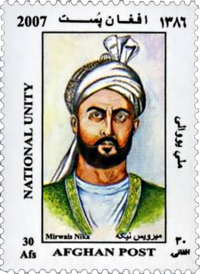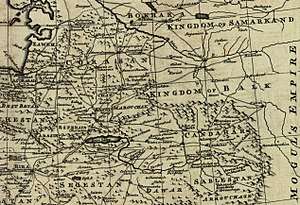Mirwais Hotak
Mīrwais Khān Hotak (Pashto: مير ويس خان هوتک) (1673 – November 1715), was an influential Pashtun tribal chief of the Ghilji Pashtuns[1][2] from Kandahar, Afghanistan, who founded the Pashtun dynasty (Hotak dynasty) that existed from 1709 - 1738.[3] After killing the Safavid Persian governor over the region, Gurgin Khan in April 1709, he declared the independant Loy Kandahar ("Greater Kandahar") region in what is now southern Afghanistan independent.[4] He is widely known as Mīrwais Bābā (ميرويس بابا, "Mirwais the father") in the Pashto language.[5][6]
| Mirwais Khan Hotak مير ويس خان هوتک | |||||
|---|---|---|---|---|---|
| Emir of Greater Afghanistan | |||||
 Sketch work of Mirwais Khan Hotak | |||||
| Emir of Afghanistan | |||||
| Reign | Hotak Empire: 1709–1715 | ||||
| Coronation | April 1709 | ||||
| Predecessor | Gurgin Khan Bahadur Shah I as Emperor of the Mughal Empire | ||||
| Successor | Abdul Aziz Hotak | ||||
| Born | Muhammad Ismail Mirwas Khan Hotak 1673 Herat, Afghanistan | ||||
| Died | November 1715 (aged 41–42) Kandahar, Afghanistan | ||||
| Burial | Kokaran, Kandahar, Afghanistan | ||||
| Spouse | Khanzada Sadozai | ||||
| |||||
| Dynasty | Hotak dynasty | ||||
| Father | Salim Khan | ||||
| Mother | Nazo Tokhi | ||||
| Religion | Sunni Islam | ||||
Rise to power
In 1707, Kandahar was in a state of chaos, fought over by the Safavid state of and the Mughal state of India. Mirwais Khan, a Pashtun tribal chief whose influence with his fellow-countrymen made him an object of suspicion, was held as a political prisoner by Gurgin Khan, the Persian governor in the region, who then sent him to the Safavid court at Isfahan. He was later freed and even allowed to meet with the Shah, Sultan Husayn, on a regular basis. Having ingratiated himself with the Persian court, Mirwais sought and obtained permission to perform the pilgrimage to Mecca in the Ottoman Empire (after which he was known as Hajji). At that time the once powerful Safavids were declining politically and militarily, riven by internal strife, royal intrigues, and endless wars against their arch rivals, the Ottomans. During his time in Persia, Mirwais, cleverly, tried to learn all the military weaknesses of the Safavids.[2][4]

While in Mecca, he sought a fatwa from the leading religious authorities against the foreign rulers who were persecuting his people in his homeland. The Pashtun tribes rankled under the ruling Safavids because of their continued attempts to forcefully convert them from Sunni to Shia Islam.[2] The fatwa was granted and he carried it with him to Iṣfahan and subsequently to Kandahar, with permission to return and strong recommendations to Gurgin Khan.
He began organizing the Pashtun tribes for a major uprising, and in April 1709, when a large part of the Persian garrison was on an expedition outside the city, he and his followers fell on the remainder and killed the majority of them, including Gurgin Khan.[4] With the death of Gurgin Khan, the Hotaki Pashtuns immediatley took control of the city by force and then the province.[6] Mirwais entered Kandahar and made an important speech to its inhabitants:
"If there are any amongst you, who have not the courage to enjoy this precious gift of liberty now dropped down to you from Heaven, let him declare himself; no harm shall be done to him: he shall be permitted to go in search of some new tyrant beyond the frontier of this happy state."[7]
— Mirwais Hotak, April 1709
Mirwais and his forces then defeated a large Persian army that was sent to regain control over the area.
Several half-hearted attempts to subdue the rebellious city having failed, the Persian Government despatched Khusraw Khán, nephew of the late Gurgín Khán, with an army of 30,000 men to effect its subjugation, but in spite of an initial success, which led the Afgháns to offer to surrender on terms, his uncompromising attitude impelled them to make a fresh desperate effort, resulting in the complete defeat of the Persian army (of whom only some 700 escaped) and the death of their general. Two years later, in A.D. 1713, another Persian army commanded by Rustam Khán was also defeated by the rebels, who thus secured possession of the whole province of Qandahár.[4]
— Edward G. Browne, 1924
Mirwais Khan became the governor of the Greater Kandahar region.[8] To the northwest were the Abdali ( now called Durrani) Pashtun tribe and to the east lay the Moghul Empire. Refusing the title of king humbly, Mirwais was referred to as "Prince of Kandahár and General of the national troops" by his Pashtun countrymen.[9]
Death and legacy
Mirwais remained in power until his death in November 1715 and was succeeded by his brother Abdul Aziz, who was later killed by Mirwais' son Mahmud, allegedly for planning to give Kandahar's sovereignty back to Persia.[8] In 1717, Mahmud took advantage of the political weakness of the Persian Shah (Sultan Husayn) and briefly conquered large parts Persia.
Mirwais is buried in his mausoleum in the Kokaran section of Kandahar, which is in the western end of the city.[10] He is regarded as one of Afghanistan's greatest national heroes and admired by many people, especially the Pashtuns. Steven Otfinoski referred to him as Afghanistan's George Washington in his 2004 book Afghanistan.[6]
Many places were named after him in honour. There is a neighborhood called Mirwais Mina as well as a hospital called Mirwais Hospital, a high school and a business center named after him in Kandahar. There are also schools and a number of institutions or places across Afghanistan built to honor him. A few direct descendants of Mirwais are living today among the Pashtun Hotak tribe.
See also
- Hotak dynasty
- History of Afghanistan
- Safavid conversion of Iran from Sunnism to Shiism
References
- Malleson, George Bruce (1878). History of Afghanistan, from the Earliest Period to the Outbreak of the War of 1878. London: Elibron.com. p. 227. ISBN 1402172788. Retrieved 2010-09-27.
- Ewans, Martin; Sir Martin Ewans (2002). Afghanistan: a short history of its people and politics. New York: Perennial. p. 30. ISBN 0060505087. Retrieved 2010-09-27.
- Axworthy, Michael (2006). Sword of Persia: Nader Shah, from tribal warrior to conquering tyrant. New York: I.B. Tauris. p. 186. ISBN 1850437068. Retrieved 2010-09-27.
- "AN OUTLINE OF THE HISTORY OF PERSIA DURING THE LAST TWO CENTURIES (A.D. 1722–1922)". Edward Granville Browne. London: Packard Humanities Institute. p. 29. Retrieved 2010-10-01.
- http://www.beepworld.de/members4/wolas/mirwaisneeka.htm
- Otfinoski, Steven (2004). Afghanistan. Infobase Publishing. p. 8. ISBN 0816050562. Retrieved 2010-09-27.
- Malleson, George Bruce (1878). History of Afghanistan, from the Earliest Period to the Outbreak of the War of 1878. London: Elibron.com. p. 227; 459. ISBN 1402172788. Retrieved 2010-11-03.
- Malleson, George Bruce (1878). History of Afghanistan, from the Earliest Period to the Outbreak of the War of 1878. London: Elibron.com. p. 234. ISBN 1402172788. Retrieved 2010-11-03.
- "AN OUTLINE OF THE HISTORY OF PERSIA DURING THE LAST TWO CENTURIES (A.D. 1722–1922)". Edward Granville Browne. London: Packard Humanities Institute. p. 29. Retrieved 2010-09-24.
- "Mir Wais Hotak (1709–1715)". Nancy Hatch Dupree. Retrieved 2010-10-01.
External links
| Wikimedia Commons has media related to Mirwais Hotak. |
| Political offices | ||
|---|---|---|
| Preceded by Gurgin Khan |
Emir of Afghanistan April 1709 – November 1715 |
Succeeded by Abdul Aziz Hotak |